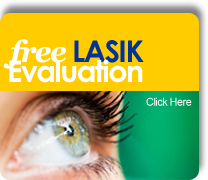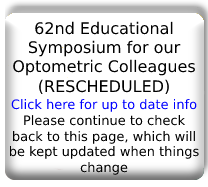Eye Care Services
Multifocal Intraocular Lenses
Newer, multifocal intraocular lenses will correct vision at multiple ranges without glasses or contact lenses. A multifocal IOL is designed with a series of "visual zones". Much like bifocals or trifocals, multifocal IOLs can correct both near and far vision.
BOTOX®
BOTOX® Cosmetic is commonly used to reduce or eliminate the appearance of facial wrinkles. It is injected under the skin into areas surrounding the eyes, forehead and mouth to smooth crow's feet, frown and worry lines, and lines on the neck. Made from a purified protein, BOTOX® relaxes wrinkles and gives the face a rejuvenated look. BOTOX® may also be useful for migraine headaches, excessive sweating, and eye and neck muscle spasms.
Cataract Care
A cataract is a cloudy area in the lens in the front of the eye. There is no pain associated with the condition but there are other symptoms, including:
- Blurred/hazy vision
- Spots in front of the eye(s)
- Sensitivity to glare
- A feeling of “film” over the eye(s)
Most people develop cataracts simply as a result of aging, with the majority of cases occurring in people over the age of 55. Other risk factors include eye injury or disease, a family history of cataracts, smoking or use of certain medications.
For people who are significantly affected by cataracts, lens replacement surgery may be recommended. During cataract replacement, the most common surgical procedure in the country, the lens is removed and replaced with an artificial one called an intraocular lens or IOL.
Cornea Treatment
The cornea is a thin, clear, spherical layer of tissue on the surface of the eye that provides a window for light to pass through. In a healthy eye, the cornea bends or refracts light rays so they focus precisely on the retina in the back of the eye.
There are many diseases that can affect the cornea, causing pain or loss of vision. Disease, infection or injury can cause the cornea to swell (called "edema") or degrade (become cloudy and reduce vision). Common diseases and disorders that affect the cornea include:
- Allergies
- Conjunctivitis ("Pink Eye")
- Dry Eye
- Corneal Dystrophies including Fuchs' Dystrophy and Lattice Dystrophy
- Glaucoma (High Eye Pressure)
- Infections
- Keratitis (Viral Inflammation)
- Keratoconus
- Ocular Herpes
- Pterygium
- Shingles (Herpes Zoster)
- Stevens-Johnson Syndrome
Treatment for corneal disease can take many forms, depending on the underlying problem as well as the patient's preferences. Some conditions resolve on their own and many can be treated with medication. If the cornea is severely damaged or if there is a risk of blindness, a corneal transplant may be recommended to preserve vision.
Learn more about the cornea and corneal disease from the National Eye Institute.
Intacs® Corneal Implants
A new FDA approved option for keratoconus filling the gap between contact lenses and a corneal transplant! Keratoconus is a progressive eye disease, which causes a thinning of the cornea, the clear front surface of the eye. As keratoconus progresses, the quality of one's vision deteriorates and contact lenses or glasses no longer become a satisfactory solution for most people. For many, an invasive corneal transplant was the only option – until now! Intacs prescription inserts are an exciting new option between contacts and a corneal transplant that may be the best possible option to stabilize the cornea and improve vision.
Intacs prescription inserts are indicated for use in the correction of nearsightedness and astigmatism for patients with Keratoconus, where contact lenses and glasses are no longer suitable.
Intacs prescription inserts are approved by the FDA for keratoconus under a Humanitarian Device Exemption (HDE).
Diabetic Eye Care
Patients with diabetes are at an increased risk of developing eye diseases that can cause vision loss and blindness, such as diabetic retinopathy, cataracts and glaucoma. These and other serious conditions often develop without vision loss or pain, so significant damage may be done to the eyes by the time the patient notices any symptoms. For this reason it is very important for diabetic patients to have their eyes examined once a year. Diagnosing and treating eye disease early can prevent vision loss. It is also important to maintain a steady blood-sugar level, take prescribed medications, follow a healthy diet, exercise regularly and avoid smoking.
Glaucoma
Glaucoma is a leading cause of blindness in the U.S. It occurs when the pressure inside the eye rises, damaging the optic nerve and causing vision loss. The condition often develops over many years without causing pain or other noticeable symptoms – so you may not experience vision loss until the disease has progressed.
Sometimes symptoms do occur. They may include:
- Blurred vision
- Loss of peripheral vision
- Halo effects around lights
- Painful or reddened eyes
People at high risk include those who are over the age of 40, diabetic, near-sighted, African-American, or who have a family history of glaucoma.
To detect glaucoma, your physician will test your visual acuity and visual field as well as the pressure in your eye. Regular eye exams help to monitor the changes in your eyesight and to determine whether you may develop glaucoma.
Once diagnosed, glaucoma can be controlled. Treatments to lower pressure in the eye include non-surgical methods such as prescription eye drops and medications, laser therapy, and surgery.
LASIK
The surgeons at Northern New Jersey Eye Institute have extensive experience performing a wide spectrum of LASIK and related refractive eye surgeries. LASIK procedures have proven to be effective at providing patients with a safe and painless option for permanently improving their vision. These procedures are capable of treating nearsightedness and farsightedness, as well as astigmatism, and eliminate the need for glasses and/or contact lenses. With the ability to perform multiple vision correction procedures, our eye surgeons will be able to recommend the procedure that is right for you. Please click here to schedule a LASIK consultation with one of our eye surgeons.
For patients interested in learning a bit more about LASIK please continue reading!
LASIK: Laser-assisted in situ keratomileusis, better known as LASIK, is the most commonly performed laser eye surgery in the United States. When the procedure is performed correctly, it eliminates or greatly reduces the patient’s need to wear glasses or use contact lenses. By reshaping the cornea, LASIK allows light to enter the eye is such a way that focuses on the retina, which allows for clear vision. The procedure is frequently used to treat and/or correct three main eye issues: myopia, hyperopia, and astigmatism. In the case of myopia (nearsightedness) the laser is used to flatten the front surface of the eye. With hyperopia (farsightedness) the laser is used to reshape and steepen the center of the cornea. And when the patient has an astigmatism, the LASIK tool is used to reshape the cornea so it becomes less steep and more spherical.
IntraLase: This procedure makes use of the IntraLase® FS laser, an extraordinarily accurate machine which fires ups to 15,000 pulses per second and assists in corneal flap creation. This allows the eye surgeon the ability to determine the optimum depth and diameter for the flap, on a patient-by-patient basis. Because this procedure is so exact, patients who undergo this procedure are less likely to require an enhancement (a follow-up procedure) than if they opt for some other laser vision correction surgeries.
LASEK: Laser epithelial keratomileusis (a.k.a. LASEK) is a vision correction procedure where the laser is directly applied to the outer surface of the eye to improve vision. During the surgical procedure the epithelial layer is cut and lifted prior to reshaping, and then it is folded back on to the eye at the conclusion of the process. Some other procedures remove the epithelial layer completely, which will regenerate over time. LASEK procedures use a tool called the trephine, which is capable of cutting a very thin flap – this is attractive to patients who have thin corneas or “steep” corneas, which cannot handle the tools used in a LASIK procedure. One potential downside of LASEK, when compared to LASIK, is that recovery time is usually longer.
PRK: Photorefractive keratectomy (PRK) is a laser vision correction surgery that is often used to deal with “low refractive” eyesight problems, and like LASEK, may be advantageous for people with thin corneas. While PRK does reshape the cornea, like other laser eye surgeries, the process involves the complete removal of the epithelial. Because of this, patients should expect to have a bandage contact lens placed over the eye(s) post-surgery to protect the eye while the epithelial regenerates.
Wavefront: This laser vision correction procedure is occasionally referred to as “custom” LASIK surgery because of the added precision that is built-in to the process. While the procedure makes use of a laser, like other procedures, the surgeon is also able to make use of a 3D map of how the light enters that particular patient’s eyes. When used in tandem, the surgeon is able to achieve a more significant degree of visual improvement than what someone would expect with more traditional vision correction procedures. Because the eye surgeon is able to create this “custom” vision correction road map, Wavefront is able to not only improve your eyesight score, but the way you see as well. That could mean an enhanced ability to see fine detail or a greater awareness of contrast, but a patient should speak with their eye surgeon to understand the exact benefits they might be able to experience, should they undertake this procedure.
Macular Degeneration
The macula is a part of the retina in the back of the eye that ensures that our central vision is clear and sharp. Age-related macular degeneration (AMD) occurs when the arteries that nourish the retina harden. Deprived of nutrients, the retinal tissues begin to weaken and die, causing vision loss. Patients may experience anything from a blurry, gray or distorted area to a blind spot in the center of vision.
AMD is the number-one cause of vision loss in the U.S. Macular degeneration doesn't cause total blindness because it doesn't affect the peripheral vision. Possible risk factors include genetics, age, diet, smoking and sunlight exposure. Regular eye exams are highly recommended to detect macular degeneration early and prevent permanent vision loss.
Symptoms of macular degeneration include:
- A gradual loss of ability to see objects clearly
- A gradual loss of color vision
- Distorted or blurry vision
- A dark or empty area appearing in the center of vision
There are two kinds of AMD: wet (neovascular/exudative) and dry (non-neovascular). About 10-15% of people with AMD have the wet form. "Neovascular" means "new vessels." Accordingly, wet AMD occurs when new blood vessels grow into the retina as the eye attempts to compensate for the blocked arteries. These new vessels are very fragile, and often leak blood and fluid between the layers of the retina. Not only does this leakage distort vision, but when the blood dries, scar tissue forms on the retina as well. This creates a dark spot in the patient's vision.
Dry AMD is much more common than wet AMD. Patients with this type of macular degeneration do not experience new vessel growth. Instead, symptoms include thinning of the retina, loss of retinal pigment and the formation of small, round particles inside the retina called drusen. Vision loss with dry AMD is slower and often less severe than with wet AMD.
Recent developments in ophthalmology allow doctors to treat many patients with early-stage AMD with the help of lasers and medication.
Accommodative Lenses
Accommodative lenses work naturally with muscles in the eye to retain the eyes' ability to focus on nearby and distant objects and everything in between. With traditional IOLs, patients lose this ability after cataract surgery and often require corrective measures such as glasses or contact lenses.
Verisyse™ Phakic Intraocular Lens(IOL)
The Verisyse Phakic Intraocular Lens (IOL) can be implanted temporarily or permanently in the eye to improve vision in patients with moderate to severe nearsightedness. Many of these patients are not candidates for other corrective treatments such as LASIK, and are resigned to wearing thick glasses or contact lenses.
The cornea acts a lens in the front of the eye, bending light rays so that they focus on the retina. In nearsighted patients the cornea is elongated or steepened, so light rays focus in front of the retina and patients suffer from blurry vision. The Verisys IOL is implanted on the iris behind the cornea to correct the way light is focused and to improve vision. The cornea is left in place to retain the ability to focus between near and distant objects. The procedure is outpatient and takes 15-30 minutes under local anesthesia.
The Verisyse IOL has been used in over 150,000 procedures worldwide with precise and predictable results. The lenses are made with PMMA, the material used in cataract surgery for the last 50 years. Please schedule an appointment or consultation to find out if the Verisyse lens is right for you. Candidates should be over 21, have good eye health and stable vision, and should not be pregnant or nursing.
Retinal Disease
The retina is a thin sheet of nerve tissue in the back of the eye where light rays are focused and transmitted to the brain. The vitreous is a gel-like substance that fills the eye and is connected to the retina, optic nerve and many blood vessels. Problems with the retina and vitreous -- including retinal tear and detachment, macular degeneration, diabetic retinopathy, infection and trauma -- can lead to vision loss and blindness. Early detection and treatment are critical in correcting problems before vision is lost or preventing further deterioration from occurring.
Eyelid Surgery (Blepharoplasty)
Blepharoplasty can rejuvenate puffy, sagging or tired-looking eyes by removing excess fat, skin and muscle from the upper and lower eyelids. It may be performed for cosmetic reasons or to improve sight by lifting droopy eyelids out of the patient's field of vision. Blepharoplasty can be combined with BOTOX® treatments to raise the eyebrows or reduce the appearance of wrinkles, crow's feet or dark circles under the eyes.
The procedure is usually performed in an office with local anesthesia and lasts 45 minutes to a few hours depending on how much work is done. Incisions are made along the eyelids in inconspicuous places (in the creases of the upper lids, and just below the lashes on the lower lids). The surgeon removes excess tissue through these incisions and then stitches them closed with fine sutures. In the case that no skin needs to be removed, the surgeon will likely perform a transconjunctival blepharoplasty, where the incision is made inside the lower eyelid and there are no visible scars.
Ptosis Repair
Ptosis is a condition in which the eyelid droops. It is caused by a weakness or separation of muscles deep within the eyelid. Ptosis does not involve excess skin or tissue in the eyelid (a condition called dermatochalasis). It is usually a result of aging, but some people develop ptosis after eye surgery or an injury, and some children are born with the condition. A brief surgical procedure can eliminate the drooping. Many young patients with mild to moderate ptosis do not need surgery early in life. Patients who are also suffering from excess skin may choose to undergo blepharoplasty at the same time as ptosis repair. Children with ptosis should be examined regularly to check for other vision problems including amblyopia ("lazy eye"), refractive errors and muscular diseases.

"Dr. Crane is one of less than 100 doctors in the United States to be able to bring this new technology to his patients."
"Dr. Crane is one of less than 100 doctors in the world who have been approved to participate in the iDose FDA trial"
iDose exchange
"Dr. Crane is one of less than 15 doctors in the United States to perform this procedure for his patients."
"Dr. Crane is one of less than 15 doctors in the world who were approved to participate in the iDose exchange FDA trial"
Infinite
"Dr. Crane is one of less than 15 doctors in the United States who were able to bring this new technology to his patients."
"Dr. Crane is one of less than 15 doctors who were approved to participate in the iStent Infinite FDA trial"
General
FDA issues warning for contaminated eye drops that can cause infection.
"Dr. Crane and Glaukos have a long history of working together on several medical device and pharmaceutical studies. He has been able to offer these technologies to his patients and the products from these studies have progressed to help treat hundreds of thousands of patients in need."
Employment Opportunity: Optometrist in Essex, Morris, and Union Counties
Dr. Crane Top Doctor 2019
Congratulations to Dr. Crane for being the 2nd surgeon in the United States to perform a new treatment for Glaucoma. We hope this treatment will bring further advances in the care of our glaucoma.
ASCRS Thanks Dr. Crane for Volunteer Work
Dr. Spier Named to OSN's Premier Surgeon 300
Dr. Spier: Weekend Comedian
Dionne Warwick on Dropless Surgery [VIDEO] (Surgery Performed by Dr. Spier)
Dr. Crane and Staff congratulate their patient Dr. William Scaife
Dr. Crane named to the ASCRS Council of 100
 Dr Crane meets one of his favorite Sharks, Daymond John, at a book signing!
Dr Crane meets one of his favorite Sharks, Daymond John, at a book signing!














